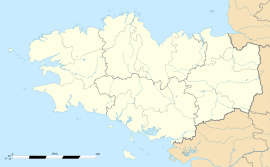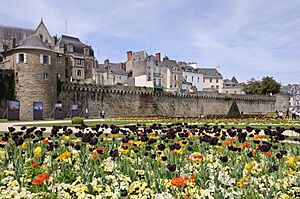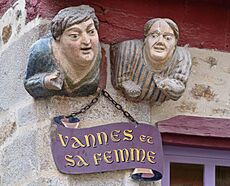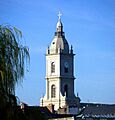Vannes facts for kids
Quick facts for kids
Vannes
Gwened
|
|||
|---|---|---|---|
|
Prefecture and commune
|
|||
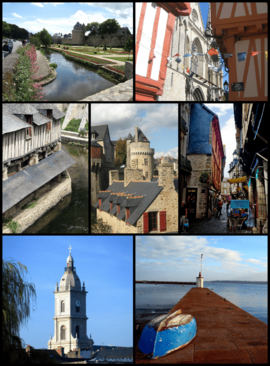
Montage of Vannes
Top left: View of Ramparts Garden of Vannes and Gaillard Castle Museum; Top right: Saint Peters Cathedral; Middle left: Vieux lavoirs, old washing place; Center: Connetable Tower; Middle right: Intra Muros narrow street; Bottom left: Saint Paterne Church; Bottom right: Conleau Pier |
|||
|
|||
| Country | France | ||
| Region | Brittany | ||
| Department | Morbihan | ||
| Arrondissement | Vannes | ||
| Canton | Vannes-1, 2 and 3 | ||
| Intercommunality | Golfe du Morbihan - Vannes Agglomération | ||
| Area
1
|
32.3 km2 (12.5 sq mi) | ||
| Population
(2021)
|
54,420 | ||
| • Density | 1,684.8/km2 (4,364/sq mi) | ||
| Time zone | UTC+01:00 (CET) | ||
| • Summer (DST) | UTC+02:00 (CEST) | ||
| INSEE/Postal code |
56260 /56000
|
||
| Elevation | 0–56 m (0–184 ft) (avg. 22 m or 72 ft) |
||
| 1 French Land Register data, which excludes lakes, ponds, glaciers > 1 km2 (0.386 sq mi or 247 acres) and river estuaries. | |||
Vannes (pronounced "VANN") is a lively city in Brittany, northwestern mainland France. It's located in the Morbihan area. This historic city was founded over 2,000 years ago and has a rich past. Today, it's a major hub and a great place to explore!
Contents
- History of Vannes: A Journey Through Time
- Geography and Climate of Vannes
- Getting Around Vannes: Transport Options
- Population of Vannes
- Monuments and Sights: What to See in Vannes
- Education in Vannes
- Vannes in Stories and Books
- Famous People from Vannes
- Sports in Vannes
- Twin Towns and Sister Cities
- Gallery
- See also
History of Vannes: A Journey Through Time
Ancient Roots: The Celtic Era
The name Vannes comes from the Veneti. They were a brave seafaring group of Celts who lived in this part of Gaul long before the Romans arrived. It seems this area was a busy trading spot for thousands of years. People likely used boats made of animal hides to trade goods across the channel, even bringing wheat from the Middle East! Around 150 BC, trade with the Thames estuary in Great Britain really grew.
Roman Rule: The City of Darioritum
In 56 BC, the Veneti people faced a big defeat by Julius Caesar's powerful fleet near Locmariaquer. After this, many Veneti were killed or sold into slavery. The Romans then built a new town called Darioritum in the same area where the Veneti used to live.
The Arrival of the Britons
From the 400s to the 600s AD, many Britons moved here. They were escaping the Saxon invasions of Britain in their homeland. These new settlers either replaced or mixed with the local Gauls. The town became known by its Breton name, Gwened, which also comes from the Veneti.
Gwened was once the center of its own independent kingdom. It was sometimes called Bro-Wened ("Vannes") or Bro-Ereg ("land of Gwereg"), named after a famous leader. The church area of Vannes was set up in the 400s. In 461, an important church meeting called the Council of Vannes was held here. Around 635, this kingdom joined with another called Domnonia under its king, Saint Judicaël.
Battles and Sieges: The Breton War of Succession
In 1342, Vannes was attacked four times during the Breton War of Succession. This was a conflict where two sides fought over who should rule Brittany. The city's commander, Olivier IV de Clisson, was captured by the English. He was later released, but the French thought he might be a traitor because his ransom was very low. So, they sadly executed him.
Vannes in the 1700s
In 1759, Vannes was a key place for a French plan to invade Britain. A large army gathered here. However, they could never set sail because the French navy was defeated in the Battle of Quiberon Bay in November 1759.
Later, in 1795, during the French Revolution, French forces in Vannes successfully stopped a planned British and Royalist invasion through Quiberon.
Geography and Climate of Vannes
Where is Vannes Located?
Vannes is right on the Gulf of Morbihan. It sits where two rivers, the Marle and the Vincin, meet the sea. The city is about 100 kilometers (62 miles) northwest of Nantes. It's also about 450 kilometers (280 miles) southwest of Paris. Vannes is a market town that has always been connected to the sea.
What's the Weather Like?
Vannes has a mild climate. It doesn't get too hot or too cold. Summers are pleasant, and winters are not usually harsh. The city gets a fair amount of rain throughout the year, but also plenty of sunshine.
| Climate data for Vannes / 1981–2010 normals, extremes 1998–present | |||||||||||||
|---|---|---|---|---|---|---|---|---|---|---|---|---|---|
| Month | Jan | Feb | Mar | Apr | May | Jun | Jul | Aug | Sep | Oct | Nov | Dec | Year |
| Record high °C (°F) | 16.7 (62.1) |
20.2 (68.4) |
23.7 (74.7) |
27.1 (80.8) |
29.9 (85.8) |
36.0 (96.8) |
37.0 (98.6) |
38.3 (100.9) |
32.1 (89.8) |
28.5 (83.3) |
20.6 (69.1) |
16.4 (61.5) |
38.3 (100.9) |
| Mean daily maximum °C (°F) | 9.5 (49.1) |
10.5 (50.9) |
13.0 (55.4) |
15.6 (60.1) |
18.6 (65.5) |
22.3 (72.1) |
23.5 (74.3) |
23.5 (74.3) |
21.7 (71.1) |
17.3 (63.1) |
12.9 (55.2) |
9.6 (49.3) |
16.5 (61.7) |
| Daily mean °C (°F) | 6.5 (43.7) |
7.0 (44.6) |
8.9 (48.0) |
11.1 (52.0) |
14.3 (57.7) |
17.4 (63.3) |
18.9 (66.0) |
18.6 (65.5) |
16.5 (61.7) |
13.4 (56.1) |
9.3 (48.7) |
6.4 (43.5) |
12.4 (54.3) |
| Mean daily minimum °C (°F) | 3.6 (38.5) |
3.5 (38.3) |
4.8 (40.6) |
6.6 (43.9) |
10.0 (50.0) |
12.5 (54.5) |
14.2 (57.6) |
13.7 (56.7) |
11.3 (52.3) |
9.6 (49.3) |
5.8 (42.4) |
3.1 (37.6) |
8.3 (46.9) |
| Mean minimum °C (°F) | — | — | — | — | — | — | 7.0 (44.6) |
6.2 (43.2) |
2.5 (36.5) |
−1.5 (29.3) |
−5.8 (21.6) |
−7.1 (19.2) |
−8.6 (16.5) |
| Record low °C (°F) | −7.4 (18.7) |
−7.3 (18.9) |
−8.6 (16.5) |
−2.6 (27.3) |
−0.6 (30.9) |
3.7 (38.7) |
7.0 (44.6) |
6.2 (43.2) |
2.5 (36.5) |
−1.5 (29.3) |
−5.8 (21.6) |
−7.1 (19.2) |
−8.6 (16.5) |
| Average precipitation mm (inches) | 99.8 (3.93) |
71.2 (2.80) |
76.8 (3.02) |
70.6 (2.78) |
62.8 (2.47) |
36.8 (1.45) |
56.8 (2.24) |
50.3 (1.98) |
60.2 (2.37) |
105.7 (4.16) |
105.3 (4.15) |
111.6 (4.39) |
907.9 (35.74) |
| Average precipitation days (≥ 1 mm) | 14.0 | 10.0 | 11.2 | 10.7 | 10.3 | 6.5 | 8.5 | 7.9 | 7.7 | 13.2 | 12.7 | 12.6 | 125.1 |
| Mean monthly sunshine hours | 74.6 | 102.2 | 151.5 | 189.9 | 203.9 | 252.3 | 246.3 | 218.5 | 207.6 | 116.5 | 91.8 | 84.4 | 1,939.4 |
| Source: Meteociel | |||||||||||||
Getting Around Vannes: Transport Options
Travel by Train
The Vannes railway station connects the city to many places. You can take a train to Quimper, Rennes, Nantes, and even Paris.
- The fast train, called the TGV, gets you to:
- Lorient in 30 minutes.
- Nantes or Rennes in about 1 hour.
- Paris in 2.5 to 4 hours.
- The Transport express régional (TER) is a slower train. It connects Vannes to nearby towns like Auray or Questembert.
- There's no direct train to Saint-Brieuc (which is 118 km away). You have to go through Rennes, which makes the trip longer and more expensive.
Driving by Car
Two main highways near Vannes make car travel easy:
- The N165 goes west to Lorient (58 km) and Quimper (122 km). It also goes southeast to Nantes (111 km).
- The N166 goes northeast to Rennes (113 km).
- Smaller roads connect Vannes to other towns.
- There isn't a highway between Vannes and Saint-Brieuc. This makes travel between northern and southern Brittany a bit harder.
Flying by Airplane
Vannes has a small airport called Vannes-Meucon airport. It's also known as "Vannes – Golfe du Morbihan airport." It used to be a military airport. Now, it's used for smaller planes, flying clubs, and skydiving schools.
Bus Services
Vannes has two bus systems:
- Kicéo: These buses offer short trips around Vannes. They start from Vannes Place de la Republique.
- CAT: These buses offer longer trips. They start from the railway station and travel around the Morbihan area.
So, Vannes has two main bus stations: one at Place de la Libération and another at the railway station.
Biking Around Vannes
Vannes has a public bike rental system called Vélocéo. It's like the bike sharing program in Paris. You can rent bikes from 10 stations around the city. Each station has 10 to 15 bikes and spaces. It's a great way to explore Vannes!
Population of Vannes
People who live in Vannes are called Vannetais. The city has grown steadily over the years.
| Historical population | |||||||||||||||||||||||||||||||||||||||||||||||||||||||||||||||||||||||||||||||||||||||||||||||||||||||||||||||||||
|---|---|---|---|---|---|---|---|---|---|---|---|---|---|---|---|---|---|---|---|---|---|---|---|---|---|---|---|---|---|---|---|---|---|---|---|---|---|---|---|---|---|---|---|---|---|---|---|---|---|---|---|---|---|---|---|---|---|---|---|---|---|---|---|---|---|---|---|---|---|---|---|---|---|---|---|---|---|---|---|---|---|---|---|---|---|---|---|---|---|---|---|---|---|---|---|---|---|---|---|---|---|---|---|---|---|---|---|---|---|---|---|---|---|---|---|
|
|
||||||||||||||||||||||||||||||||||||||||||||||||||||||||||||||||||||||||||||||||||||||||||||||||||||||||||||||||||
| Source: EHESS and INSEE (1968–2017) | |||||||||||||||||||||||||||||||||||||||||||||||||||||||||||||||||||||||||||||||||||||||||||||||||||||||||||||||||||
Monuments and Sights: What to See in Vannes
Vannes is full of amazing historical buildings and fun places to visit.
- Cathedral of St Peter: A beautiful Gothic church.
- Church of St Patern: A classic church.
- Chapel of Saint-Yves: A church built in the Baroque style.
- Château Gaillard: A medieval house that is now an archaeological museum.
- Musée de la Cohue: A museum with fine art.
- Hôtel de Ville: The city hall building.
- Old city walls: These ancient walls protected the city. They include:
- Tour du Connétable: A large medieval tower.
- Château de l'Hermine: A former castle that became a palace. It was once home to the Dukes of Brittany.
- Porte Calmont, Porte Prison, Porte Poterne, Porte Saint-Jean: These are medieval city gates.
- Porte Saint-Vincent: An 18th-century city gate.
- Many timber-framed houses: You can see these charming old houses in the historic part of town.
- "Vannes and his wife": A funny painted granite sculpture from the 1400s. It stands in front of Château Gaillard.
- The harbour: A lovely place to walk and see boats.
Education in Vannes
Vannes has several important schools and universities:
- École nationale supérieure d'ingénieurs de Bretagne Sud: An engineering school.
- Institut catholique d'arts et métiers: Another engineering school.
- Southern Brittany University: A university with many different subjects.
Breton Language in Schools
The city of Vannes supports the Breton language. In 2007, they started a plan called Ya d'ar brezhoneg to encourage its use. By 2008, almost 8% of children in primary schools were learning in bilingual (Breton and French) classes.
Vannes in Stories and Books
Vannes has appeared in many fictional works:
- In The Vicomte of Bragelonne: Ten Years Later (1847) by Alexandre Dumas, the character Aramis becomes the bishop of Vannes.
- Sébastien Roch (1890) by Octave Mirbeau tells the story of Sebastien, who goes to a school in Vannes.
- In Sir Nigel (1906) by Sir Arthur Conan Doyle, Nigel becomes the leader of Vannes Castle after a battle.
- Jean-François Parot wrote crime novels set in the 1700s. His main character, Nicolas Le Floch, also went to school in Vannes. These books were even made into a TV series!
- The Secret of the Missing Boat (1966) by Paul Berna is a children's book set in the area.
- Vannes is also a key location in C.J. Adrien's novel The Oath of the Father (2015), which is about Viking raids in Brittany.
Famous People from Vannes
Many notable people have come from Vannes, including:
- Albinus of Angers (born 469): A Roman Catholic saint.
- Saint Emilion (?–767): A monk and saint who gave his name to a famous wine region.
- François I (1414–1450): A Duke of Brittany.
- Louis-Marie Autissier (1772–1830): A painter.
- Armand Alexandre de Castagny (1807–1900): A military general.
- Louise Bourgoin (born 1981): An actress.
- Paul César Helleu (1859–1927): A painter.
- Alain Resnais (1922–2014): A famous film director.
- Yves Coppens (born 1934): A paleontologist, who studies fossils.
- Claude-Michel Schönberg (born 1944): A singer and songwriter, known for musicals like Les Misérables.
- Hélène de Fougerolles (born 1973): An actress.
- Mathieu Berson (born 1980): A footballer.
- Yann Kermorgant (born 1981): A footballer.
- Julian Chartier (born 1999): A gymnast.
Sports in Vannes
Vannes has a strong sports scene:
- The local football (soccer) team is Vannes OC. They play in the 5th tier of French football.
- The Rugby Club Vannes is the city's rugby team. They compete in Pro D2, a high level of rugby in France.
Both teams play at the Stade de la Rabine, which was built in 2001. The town was also the starting point for stage 9 of the 2015 Tour de France cycling race.
Twin Towns and Sister Cities
Vannes has special friendships with other cities around the world. These are called "twin towns" or "sister cities":
 Mons, Belgium (since 1952)
Mons, Belgium (since 1952) Cuxhaven, Germany (since 1963)
Cuxhaven, Germany (since 1963) Fareham, England, United Kingdom (since 1967)
Fareham, England, United Kingdom (since 1967) Wałbrzych, Poland (since 2001)
Wałbrzych, Poland (since 2001) Ballymoney, Northern Ireland, United Kingdom (since 2001)
Ballymoney, Northern Ireland, United Kingdom (since 2001)
Gallery
See also
 In Spanish: Vannes para niños
In Spanish: Vannes para niños





